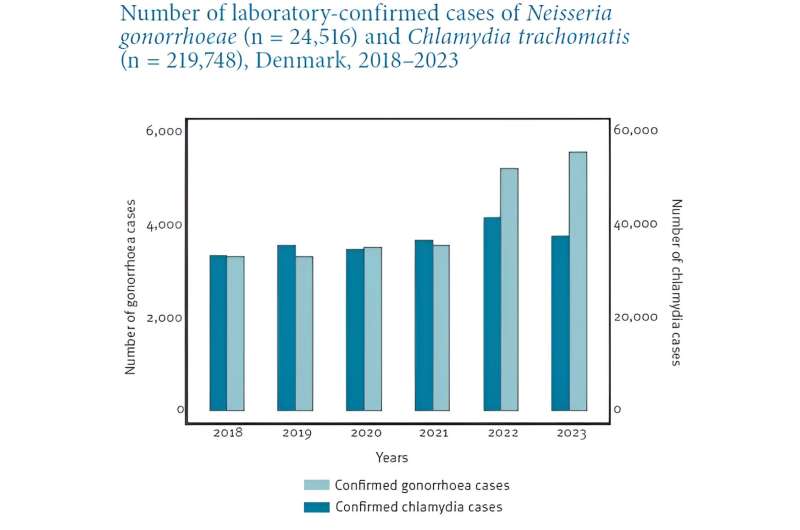This article has been reviewed according to Science X's editorial process and policies. Editors have highlighted the following attributes while ensuring the content's credibility:
fact-checked
proofread
Surge in gonorrhea cases in Denmark: Up by 46% between 2021 and 2022

Across the European continent, sexually transmitted infections (STI) caused by Neisseria gonorrhoeae have gone up in recent years, according to data from the European Centre for Disease Prevention and Control. New data from Denmark, just published in Eurosurveillance, confirm this trend.
National Danish surveillance data presented by Pedersen et al. show a rise in the number of cases of both gonorrhea and chlamydia over the last 5 years. Between 2018 and 2023, a total of 24,516 gonorrhea cases have been notified in Denmark. Reports of gonorrhea went up sharply (46%) between 2021 and 2022 and increased even further in 2023 (7%) compared with 2022.
Similar to observations from other European countries, the increase in gonorrhea cases in Denmark affected both men and women. However, the surge was larger among younger women in their early- to mid-twenties (median) and men who have sex with women compared with men who have sex with men (MSM), another population group at risk of gonorrhea.
Even though the number of performed tests went up from 2022, the authors note that this did not account for the increase in gonorrhea cases in Denmark.
In 2020, overall infections decreased significantly due to the COVID-19 pandemic and related restrictions that were subsequently lifted in 2022. which in turn has been associated with an increase in respiratory infections as well as gonorrhea. Pedersen et al. note that "in Denmark, the final COVID-19 restrictions were lifted February 2022, which likely prompted behavioral changes that may have contributed to the sharp increase in gonorrhea cases".
Understanding spread and drivers of infection with surveillance data and genomics
In their article, Pedersen et al. used national surveillance data and genomics to understand the spread and potential drivers of N. gonorrhoeae infections.
The authors selected 331 representative N. gonorrhoeae isolates from across the country and performed whole genome sequencing to explore if there might be any underlying evolutionary factors that could be linked to the increase in gonorrhea cases, especially among young women and heterosexual men.
Based on 147 sequenced isolates, three distinct clades were identified; overlaying of epidemiological data regarding sex, age, and reported sexual orientation showed a significant overrepresentation of heterosexual transmission (99% of men who have sex with women or women) compared with isolates outside these clades (76%).
Pedersen et al. found that a "unique combination of genomic and epidemiological data that include sexual orientation clearly depicts that distinct lineages have increased in prevalence in different geographical regions of Denmark and almost exclusively disconnected from the MSM community."
The authors also found that the examined clades driving the increase among men who have sex with women and women were highly susceptible to the common gonorrhea treatment regimen in contrast to the variants circulating especially among MSM.
Based on the limited availability of genomic data, the authors state that "it is currently unclear if the lineages that drive the increase of gonorrhea in men who have sex with women and women elsewhere in Europe all share common genetic backgrounds. The recent increase in gonorrhea relative to chlamydia cannot be explained by antibiotic resistance among the key N. gonorrhoeae lineages."
"Rather, we hypothesize that these lineages may cause infection with no or low-grade symptoms and/or higher transmissibility. In addition, they may have become more prevalent in populations that are younger, more sexually active, and have multiple partners."
Pedersen et al. conclude that "knowledge of distinct N. gonorrhoeae clones and their circulation in certain demographic groups aid in our understanding of transmission patterns, as does the observation of susceptibility of N. gonorrhoeae among these clades that can inform targeted interventions and identify populations at risk."
More information: Thomas Roland Pedersen et al, Gonorrhoea on the rise in Denmark since 2022: distinct clones drive increase in heterosexual individuals, Eurosurveillance (2024). DOI: 10.2807/1560-7917.ES.2024.29.7.2400059



















